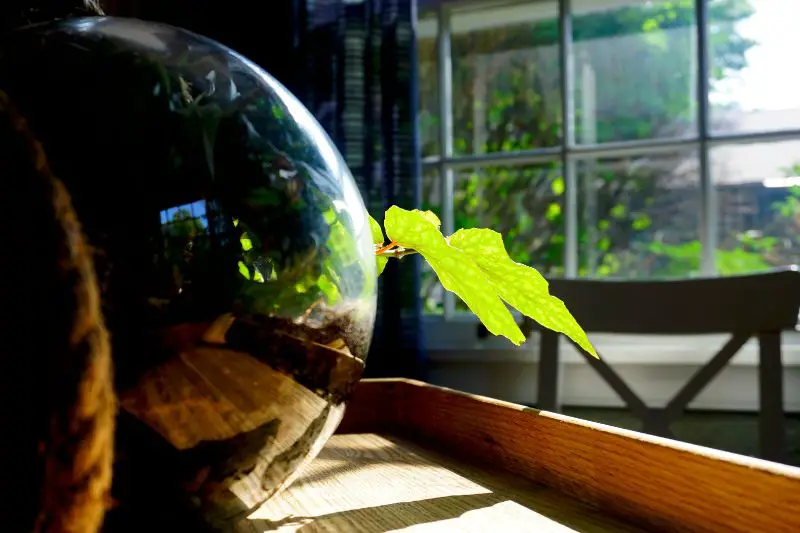This page may contain affiliate links that allow us to make a small commission from qualifying purchases (at no extra cost to yourself). We appreciate your support.
If you’re anything like me, then you love a well-planted indoor garden. Whether you’re planting a vivarium or a terrarium, it’s a fun and beneficial pastime. However, with all the work to set up a good-looking terrarium, you’re likely to question the lighting requirements, just as I have done. I mean, is sunlight the way to go here, or is artificial lighting the way to go?
Terrariums planted with living plants will require light sufficient for the well-being of the plants to thrive. Direct sunlight may be too powerful for a typically planted indoor terrarium, making indirect, filtered, or artificial lighting your best options.
Let’s take a look at a few aspects of terrarium lighting that you should consider. I have extensive knowledge of terrarium care, having kept so many variations over the years myself. With that in mind, I’ll share my knowledge of terrarium lighting and what you should do for your terrarium. Let’s start with a little background about light itself relating to terrariums and plants.
What You Need to Know About Terrariums and Sunlight
If you’ve spent any length of time on this planet, you’ve got to have a rudimentary knowledge of the Sun regarding how intense the rays are. Who hasn’t had a sunburn at least once in their life? Okay, I have some friends from the Caribbean who might argue this with me, but for the most part, the sun gives most people burns if overexposed to Ultraviolet Radiation.
Terrarium Type Vs. Light – Plastics
Terrariums are usually constructed using glass, but there are plastic versions on the market. Direct sunlight affects certain plastics in different ways and can cause yellowing or even the plastic to melt. Therefore, we need to consider the effects of direct sunlight on the terrarium structure itself.
Terrarium Type Vs. Light – Glass
At this point, you are likely not to consider using most plastic terrariums if direct sunlight is involved. To be quite honest, glass is the more common type of terrarium I’ve encountered anyway, so let’s look at that more.
Terrarium glass is sun-proof. However, the plastic framing or silicone adhesive holding the glass together is not sun-proof. In most cases, it isn’t even sun resistant. It is widely known in many industries that use silicone that silicone becomes noticeably degraded over time due to UV exposure.
Furthermore, most aquarium and terrarium manufacturers use a black plastic framing around their glass terrariums or aquariums. This black plastic framing tends to melt and warp in the sun’s heat. Therefore, I don’t advise using a terrarium that uses black plastic if your plant preferences require direct sunlight. What is direct sunlight, though? We need to be clear about this (no pun intended).
Strength of Light: Direct Sunlight Vs Indirect Sunlight Vs Artificial Light

The strength of light is extremely important to consider as it can have a direct effect on your plant’s health within your terrarium. As you know, the closer to the equator, the stronger the rays can be due to less atmosphere for the rays to filter through. But on a more microscopic level, the types of sunlight you’re going to encounter are: direct, indirect, and filtered.
Direct Sunlight – Light rays that pass through our atmosphere and strike an object (like a plant) directly.
Indirect Sunlight – Light rays that reflect off objects in the surrounding environment and strike other objects. Think of the shade under a tree. On a sunny day, you can see that the shaded area is well-lit by reflected light.
Filtered Sunlight – Light rays that pass-through materials like glass, acrylic, lexan, or other clear or semi-transparent plastics.
Artificial Light – Light created via a human-made technology such as LED, incandescent bulb, fluorescent bulb, or another type.
Filtered glass is an interesting topic. Regular glass will block a lot of UV-B, if not most. However, the amount of UV-A blocked is rather insignificant.
Light and Heating
Light also tends to heat things. So, if your terrarium has a top on it without proper venting and is exposed to direct sunlight, it will cook anything inside. Just think of a car sitting out in the sun. Get inside and feel the heat – that’s from sunlight, my friend!
Terrarium Plants and Light Requirements
Most plants need sunlight, albeit many are fine with indirect, or glass filtered. However, again we need to consider if the terrarium is open or closed. A closed system terrarium will cook in direct sunlight, as mentioned above in the heating section. However, an open terrarium might be better suited for direct or filtered sunlight, depending on the plant life chosen.

Open and Closed Terrarium Plants and Lighting
I won’t go too in-depth here about open vs closed terrariums (you can read all about them in my guide to terrarium maintenance here), suffice it to say that a closed system utilizes plants that thrive in warmer, high humidity conditions.
For a closed terrarium system, you’re likely to want to use artificial or indirect lighting only. Direct sunlight or filtered (via a window plus your terrarium sidewall) will be too powerful for a closed system and likely cook everything inside.
Typical plants for closed system terrariums:
- Ferns
- Moss
- Nerve Plant (Fittonia)
- Peperomia (Peperomia Pellucida)
Open system terrariums are much more forgiving than closed systems and the plants are usually more rugged. I’ve grown everything from cactus to begonias in an open terrarium. They are also better suited for outdoor terrariums if you’re going to place one in your landscape.
Many of the plants that do well in open terrariums will vary in light requirements based on the species. For example, many cactus species are okay with as much direct sunlight as you can give them. Similarly, they won’t mind the few degrees warmer an outdoor terrarium will be in the sun.
For example, some of the other species, like Strawberry Begonias, won’t tolerate so much direct sunlight and do much better in indirect sunlight or even artificial lighting. I’ve also grown African Violets in open terrariums, and these sorts of plants will wither and die in direct sun. For most open terrariums kept indoors, indirect sunlight and artificial lighting are usually the best two options
The Best Solution for Artificial Terrarium Lighting
Artificial lighting for your terrarium is easy to find but often misunderstood. Most plants want a decent amount of light. Even indirect sunlight is very powerful compared to an incandescent light bulb. However, that’s not to say you need to go out and buy metal halide grow lights either.
For most terrarium setups, a decent quality LED grow light will suffice. Again, you need to know the light requirements of your chosen plants to make a practical choice. Similarly, the size of your terrarium will determine the lighting, as will the life you decide, if more than just plants (like exotic reptiles for example).
For more miniature terrariums, I like to use a grow light with a flexible gooseneck so I can adjust it accordingly. I have one from a few years ago, but the latest one that works well and is readily available, is the GooingTop LED Grow Light.
You can pick it up off Amazon for a really reasonable price and it’s well-received by verified reviewers, so you know it’s got to work well.
Of course, if you’re setting up a tropical terrarium, something more extensive like a 50-gallon tank, you’re going to want to look at a solution more like a two-foot-long LED grow light that delivers close to full spectrum.
I’ve got a couple of tanks I set up using some 25-watt, 2-foot long grow lights and you can pick up a four-pack of LED grow lights pretty cheap at Amazon.

Meet Brad, the creator behind Vivarium Vibes, where his deep connection with nature and animals truly comes to life.

